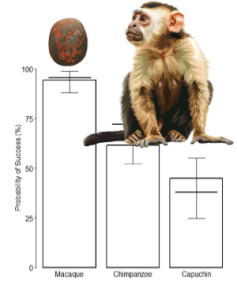
Chimpanzees, capuchins, and long-tailed macaques use tools to crack the shells of nuts. They place the nut on a hard surface, like a flat rock, and strike it with a stone to crack the shell. These three primate species use different techniques. Chimpanzees and macaques crack the nuts while sitting, but the capuchin stands on two legs and uses both hands to raise the cracking stone above its head. (View this amazing technique on Youtube!)
This graph shows the success rates of the three different primates. The data is from a Nature article that goes into further detail about the study and methods. The graph shows error bars, and some younger students may not be familiar with that notation. However, students do not need to understand error bars to interpret the graph.
You can use this activity as an opener for lessons on animal behavior, or as a stand-alone data analysis exercise. Students view the graph and suggest the CLAIM that is being made. Next, they summarize the graph to provide EVIDENCE for the claim. Finally, they write a REASONING statement that connects the claim and the evidence. Students can also view a short video showing how capuchins crack open nuts.

Another topic you can explore is the idea of “tool use” as a behavior. Some students may believe that only humans use tools, which is an old, but persistent misconception. Lots of animals use tools! If students don’t have a lot of background information on primates, give them a short tutorial with this set of primate figurines.
Claim, Evidence, Reasoning
I use graphs and data analysis throughout the year. You can find CER’s for just about any topic at this page. Most of the worksheets are short, mainly for openers or embedded within slides on at topic. For example, if your class is studying genetic modification, you can do this CER on the European Corn Borer.
Since most standardized tests use graphs and data to assess a student’s understanding of science, I think it is important for students to have lots of practice interpreting data. Plus, a 5 minute CER in the middle of a lesson can be a needed change of pace from lectures. You can also integrate CER into labs, where students gather their own data and support/reject a hypothesis (claim).

